Rosacea with Acne
Acne rosacea is a subtype characterized by facial redness, visible blood vessels, acne breakouts, pimples, and pustules on the skin’s surface. Rosacea patients often have to deal with acne rosacea during flare-ups, which can lead to feelings of frustration and embarrassment. The clinical symptoms of acne rosacea flare-ups are similar to another common skin condition called acne vulgaris. Determining if your breakout is due to rosacea or acne vulgaris is essential, as topical skincare products designed to treat acne vulgaris can aggravate rosacea symptoms. Consulting with an expert, board-certified dermatologist, like Dr. Michele Green in NYC, is the best way to correctly diagnose acne rosacea and develop an acne rosacea treatment plan.
One of the most challenging aspects for a patient with acne rosacea is understanding how to properly treat the pimples and red bumps on the skin’s surface. While the cause of acne rosacea is unknown, environmental and lifestyle factors can trigger flare-ups and worsen symptoms. Dr. Michele Green in NYC utilizes the most cutting-edge treatments in her private dermatology office to treat acne rosacea flare-ups for clear, healthy skin. Laser treatments like the V-Beam laser can reduce redness and facial telangiectasia without downtime. Oral and topical antibiotics can help to reduce redness, swelling, and acne rosacea breakouts. If you suffer from acne rosacea, facial redness, visible blood vessels, or other rosacea symptoms, board-certified dermatologist Dr. Green is here to help.
Dr. Michele Green is a world-renowned expert in the field of dermatology, with over two and a half decades of experience treating some of the most discerning patients from around the world. Dr. Green customizes each patient’s treatment approach and is consistently identified as one of New York’s best dermatologists by Castle Connolly, Super Doctors, The New York Times, and New York Magazine for her dedication to her patients and expertise. When you consult with Dr. Green, she will help you select the proper skin care regimen, oral and topical treatments, and any cosmetic procedures necessary to improve the condition of your acne rosacea. Whether it be VBeam® laser treatments, HydraFacials, or topical antibiotics, Dr. Green is here to help you manage your acne rosacea and achieve and maintain beautiful, healthy skin.
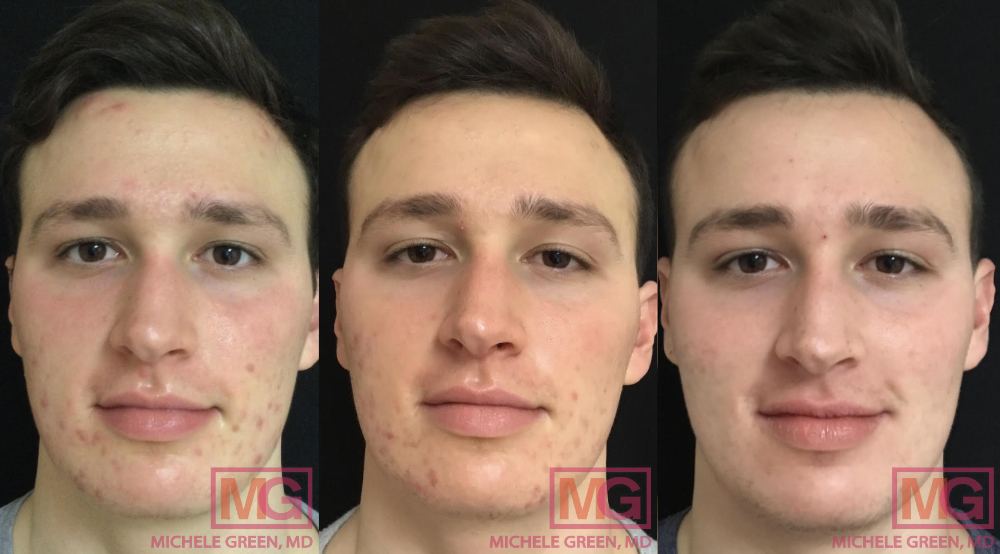
Accutane for Acne, 1 and 5 months before and after
What is rosacea?
Rosacea is an inflammatory skin condition characterized by facial redness and flushing akin to a sunburn, often accompanied by broken blood vessels and small red bumps that may resemble an acne breakout. Other rosacea symptoms include eye problems, dry skin, and a stinging or burning sensation. Most commonly, rosacea is found on the center of the face, including the bridge of the nose and the cheeks, the forehead, and the chin. There are four main subtypes of rosacea:
Subtype 1: Erythematotelangiectatic rosacea – erythema (facial redness), flushing, and visible small blood vessels.
Subtype 2: Papulopustular rosacea – acne-like breakouts and a characteristic inflammatory response on the skin’s surface. This is the most common form of rosacea, also called acne rosacea.
Subtype 3: Phymatous rosacea – a rare type characterized by facial skin thickening that most commonly happens on the nose (rhinophyma rosacea). This form of acne rosacea stems from cases of severe rosacea that are left untreated and particularly common in men aged 50 to 70.
Subtype 4: Ocular rosacea – characterized by eye irritation, redness around the eyes, and swollen eyelids. Patients may develop scales and crusts on the eyelashes, which can be misdiagnosed as seborrheic dermatitis. Additionally, patients may have eye symptoms and think they have styes when, in fact, they are suffering from ocular rosacea.
What is acne rosacea (papulopustular rosacea)?
Papulopustular rosacea, commonly known as acne rosacea, is a subtype characterized by small red bumps and pustules across the skin’s surface. Most commonly found on the cheeks, chin, and forehead, acne rosacea may result in as many as 40 bumps spread across the face. While these blemishes may look similar to a breakout of traditional acne, they are, in fact, different. Traditional acne occurs when the pores on the skin become clogged with dead skin cells, oil, and other debris from the skin’s surface, causing whiteheads or blackheads. In some acne breakouts, the blemish can become infected with bacteria or filled with pus, leading to inflammatory acne. The cause of acne rosacea is unknown, though there are biological and environmental risk factors that can lead to an outbreak. The appearance of papulopustular rosacea also differs from traditional acne in that blemishes caused by rosacea are often accompanied by visible blood vessels and a diffuse redness across the face. Traditional acne, on the other hand, usually only has visible redness around the blemishes themselves.
What do rosacea pimples look like?
Characterized by redness that diffuses the whole face, rosacea pimples often manifest as many inflamed blemishes that may or may not be filled with pus. Usually, blood vessels are visible under the skin in the affected area, further contributing to skin discoloration. General swelling and inflammation may appear on the face surrounding the blemishes.
Severe acne rosacea can result in inflammation and irritation of the skin, creating significant, painful red bumps that look similar to cystic acne lesions. In some cases, patients may be dealing with acne rosacea and acne vulgaris, which must be treated carefully to prevent worsening skin irritation or further infection. If left untreated, signs of rosacea, such as facial redness and red bumps, may worsen over time and, in severe cases, may cause the nose to become misshapen (rhinophyma rosacea) or cause the eyes and eyelids to become dry and irritated (ocular rosacea).
Where does rosacea appear on the body?
Rosacea appears most commonly on the nose, cheeks, chin, and forehead bridge. Though less common, rosacea symptoms may also affect the neck, back, and chest. In some cases, the eyes and eyelids may be affected by what is known as ocular rosacea.
What is the main cause of rosacea acne?
Unfortunately, the specific cause of rosacea acne is still unknown. Some researchers suggest that rosacea may be an autoimmune disease, meaning that patients with rosacea have an immunological basis for their rosacea. Some common risk factors may increase the likelihood of developing rosacea. Patients with a family history of rosacea are more likely to experience rosacea than those without, suggesting a possible genetic link. Age tends to be a common factor, with most cases of rosacea affecting patients between 30 and 50. Patients with fair skin or Scandinavian or Celtic ancestry are more commonly affected by rosacea. Additionally, women are more likely to develop rosacea than men, though men often have more severe symptoms. While the exact cause of the condition is unknown, patients can help reduce the likelihood of a rosacea flare-up by avoiding their potential environmental and biological triggers.
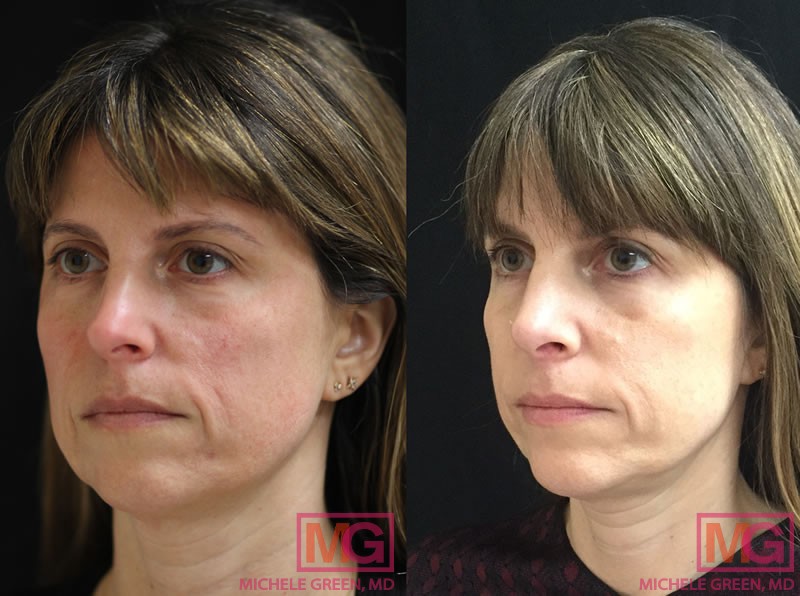
Female treated with VBeam and Thermage
Why do I get acne rosacea?
For many patients dealing with cases of rosacea, it can be helpful to highlight triggers or environmental factors that may be causing a flare-up. Where traditional acne is caused by clogged pores, improper hygiene, and hormonal shifts, rosacea pimples have complex risk factors and triggers. The exact cause of Rosacea is unknown, but several environmental and lifestyle factors can trigger the onset of Rosacea pimples, including:
- Extreme heat
- Extreme cold
- Sun exposure
- Dietary triggers (alcohol, hot beverages, spicy foods)
- Emotional stress
- Harsh skin products (retinol, certain acids)
- Irritation from face masks
- High concentrations of Demodex folliculorum (skin mites), H. pylori (gut bacteria), cathelicidin (protective skin protein)
Recent research published by the National Rosacea Society suggests that acne vulgaris breakouts are more common in patients with rosacea. Though the exact reason for this is unknown, studies indicate that rosacea can contribute to a change or increase in sebum production, which can clog the pores, leading to breakouts of acne vulgaris. Patients with rosacea should take extra care to cleanse the skin with a gentle cleanser and apply a non-comedogenic moisturizer to keep the skin clean and hydrated and prevent acne breakouts.
When does acne rosacea appear?
Acne rosacea typically appears in patients between 30 and 50 years of age. However, any individual experiencing rosacea symptoms can develop acne rosacea. Acne rosacea may appear due to specific triggers, such as extreme temperatures, specific diets, and emotional stress.
Is it acne or rosacea?
Rosacea is similar to acne vulgaris but is not the same skin disease. Acne rosacea flareups can present as redness, pustules, raised patches, facial telangiectasia, and broken blood vessels, akin to traditional acne vulgaris breakouts. Breakouts from acne vulgaris are formed due to pores clogged with excess sebum and dead skin cells. Both rosacea and acne flare-ups can be triggered by environmental and lifestyle factors such as extreme temperatures and spicy foods. Acne vulgaris is associated with redness around the pimples, while rosacea causes diffuse redness across the face. When assessing whether you are dealing with acne vulgaris or acne rosacea, it is essential to consult with a board-certified dermatologist like Dr. Green. Dr. Green is an expert in acne and rosacea and will assess your skin and the severity of symptoms to create a tailored treatment plan to leave you with clear, healthy, radiant skin.
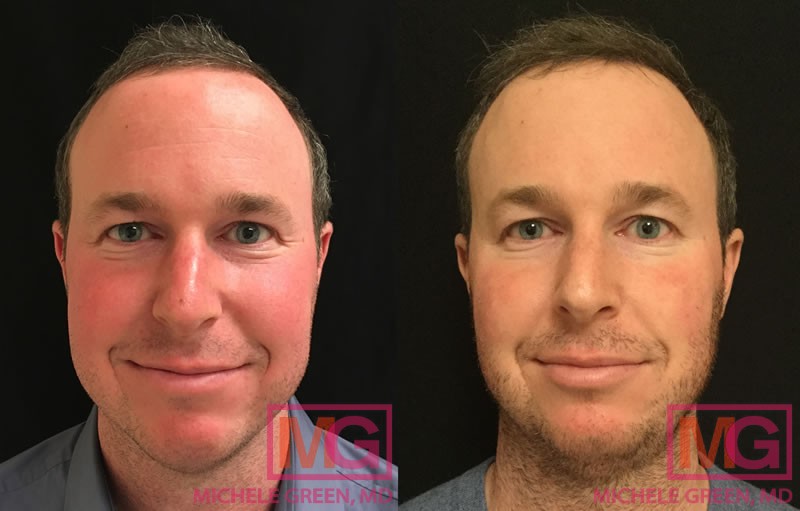
Male treated with VBeam for Rosacea
Is rosacea treatment and acne treatment the same?
While there may be some overlap in treatment options, Rosacea and traditional acne should be treated differently. Acne rosacea and traditional acne can look very similar, and sometimes, patients with acne rosacea believe they are experiencing a breakout of acne vulgaris. Patients must be careful, however, as some safe and effective treatments for acne vulgaris can worsen rosacea symptoms. Patients with rosacea often have sensitive skin, so acid-based or retinol-based therapies that are safe and effective for acne vulgaris treatments in most of the population can further irritate and exacerbate rosacea symptoms. Some treatments for acne vulgaris overlap with treatments for rosacea, including VBeam laser treatment, which can reduce redness in both skin conditions. The most critical first step for both acne vulgaris treatment and Rosacea treatment is to consult an expert dermatologist, such as Dr. Green, who can correctly identify your skin condition and determine the treatment that will be safest and most effective for you.
Will acne rosacea go away?
No, acne rosacea is a chronic skin condition. While symptoms may flare up for weeks or months and dissipate, acne rosacea can recur. The best way to manage acne rosacea is to consult a board-certified dermatologist such as Dr. Michele Green in NYC, who can create a treatment regimen to control flare-ups.
How do you treat rosacea acne?
While there is no cure for rosacea, several treatment options are available to help manage symptoms and prevent flare-ups. Topical treatments are typically recommended for mild symptoms of rosacea, while oral medications are reserved for treating moderate to severe symptoms of rosacea. Often, patients will use a combination of photodynamic treatments, laser treatments, medications, and skin care products to reduce the appearance of rosacea symptoms. When you consult with Dr. Michele Green at her private dermatology office in the Upper East Side neighborhood of Manhattan, she will work with you to create a customized acne rosacea treatment plan best suited to your unique needs and skin condition.
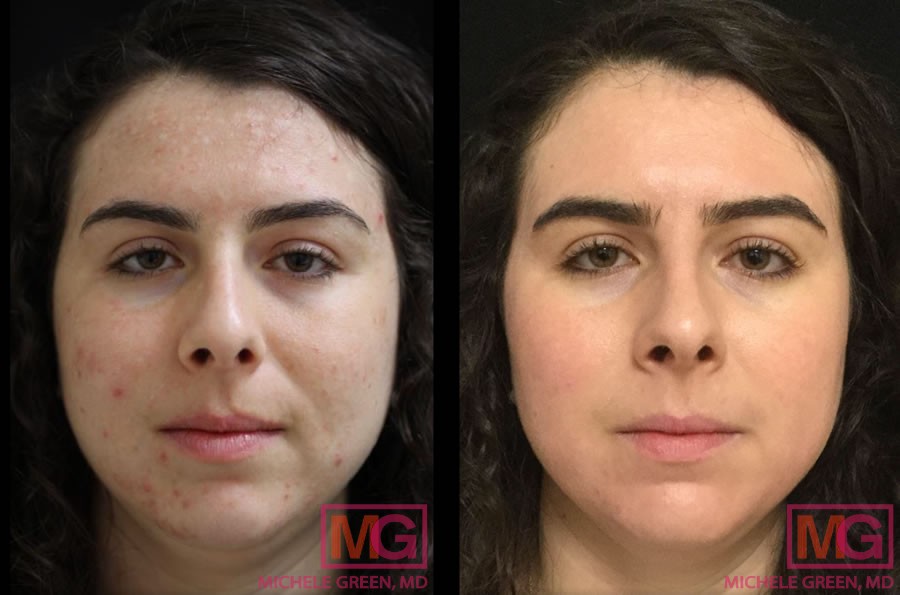
Female treated for acne – 8 months before and after
In-office acne rosacea treatment options
The VBeam Pulsed Dye laser is one of the most popular rosacea treatment options, as it’s able to remove redness and visible blood vessels quickly and effectively. Additionally, the VBeam laser can shrink the size of blood vessels, preventing further redness from developing. There is no downtime or side effects associated with the VBeam laser, making it the perfect rosacea laser treatment for all skin types and tones. Five to six treatment sessions spaced one month apart are necessary for optimal results, followed by maintenance sessions to enhance and keep the results from treatment.
Intense Pulsed Light therapy (IPL), also called photo rejuvenation or a photo facial, is an anti-aging treatment that utilizes different wavelengths of light to improve facial redness, pigmentation, and skin tone and texture with minimal downtime. Patients treating recurrent acne rosacea typically require an average of five to six IPL treatment sessions, each spaced approximately four weeks apart, to achieve the final desired results. Most patients undergo an annual maintenance treatment session to maintain the best results.
Photodynamic therapy (PDT) uses a photosensitizing molecule and intense blue light to heal and soothe the skin from acne rosacea. A topical photosensitizing medication is placed on your facial skin for one hour; after removal, the skin is directly exposed to the blue light to activate the acne rosacea lesions and help heal your rosacea and its associated breakout. The surrounding skin is unaffected, as only the acne rosacea lesions absorb the medication.
A HydraFacial is a medical-grade exfoliation treatment that uses a three-step process of cleansing, exfoliating, and infusing nourishing serums to repair the skin and reduce the appearance of rosacea. Red and blue LED lights can reduce redness, acne-causing bacteria, fine lines, and wrinkles on the skin’s surface. For patients struggling with rosacea, the Rozatrol booster can be added to treatment, reducing the redness commonly caused by rosacea. HydraFacials are also an excellent option for patients struggling with a combination of rosacea and acne vulgaris and those looking to treat discoloration and facial wrinkles.
Topical skincare treatments
Topical skincare products can help reduce rosacea symptoms, including redness, inflammation, and the appearance of acne rosacea. Dr. Green can prescribe specific topical antibiotics and treatments for acne rosacea, including:
- Azelaic acid: a gel that treats Rosacea’s papules, pustules, and inflammatory components.
- Metrogel® (Metronidazole): a standard rosacea antibiotic medication that prevents and treats facial Rosacea and redness.
- Mirvaso® (Brimonidine) gel: a topical, once-daily medication that narrows blood vessels to reduce redness from Rosacea.
- Soolantra® (Ivermectin): an excellent option to treat Rosacea’s inflammatory and erythema components.
As sun exposure is a common trigger for many rosacea patients, Dr. Green recommends using a daily, broad-spectrum sunscreen with a minimum SPF of 50. Patients may also benefit from layering a physical and chemical sunscreen for maximum protection. Physical sunscreens contain ingredients such as titanium dioxide and zinc oxide, forming a physical barrier on the skin to protect it from harmful UV rays. Chemical sunscreens contain ingredients such as oxybenzone and avobenzone.
Vitamin C is an excellent skincare ingredient that helps reduce facial redness and rejuvenate the skin. It is a powerful antioxidant that stimulates collagen production, accelerates cell rate turnover, and protects the skin from free radical damage and oxidative stress. Dr. Green’s best-selling Vita-C-Serum from her proprietary line, MGSKINLABs, Inc., is available here.
Patients with acne rosacea must be careful with their skincare products, only using gentle cleansers and non-comedogenic, oil-free lotions. They should not use products designed to treat acne vulgaris on skin with rosacea. Often, acne vulgaris treatment products contain acids such as salicylic acid and retinol, which can be too harsh for skin made extra sensitive by rosacea. Applying these products can worsen rosacea symptoms, so it is essential to consult an expert dermatologist, such as Dr. Green, before attempting to treat rosacea with topical creams.
Oral medications for rosacea treatment
Oral antibiotics, including doxycycline, minocycline, or tetracycline, are a standard treatment option for acne rosacea. Dr. Green typically prescribes Oracea (doxycycline) for facial or acne rosacea. In the case of severe acne rosacea, Dr. Green may recommend Isotretinoin (Accutane) to heal the skin from breakouts of chronic pustules or blemishes due to acne rosacea. Isotretinoin is more commonly used to treat acne vulgaris, but it can be an effective method to treat acne rosacea in some cases.
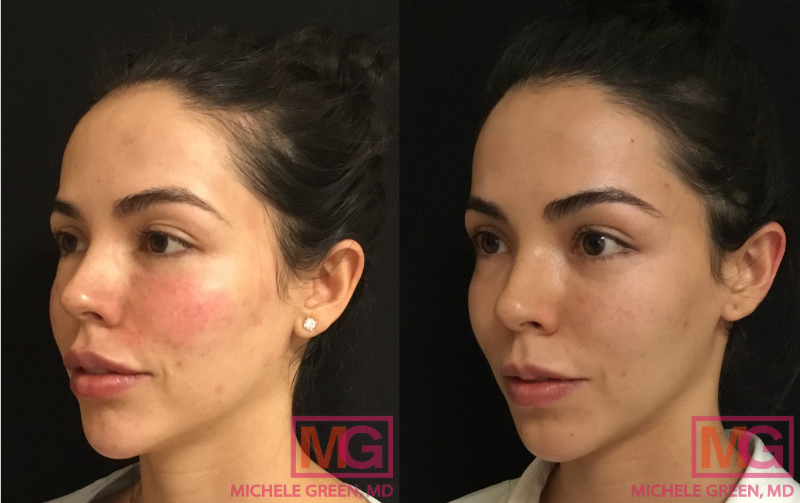
Can retinol help with acne rosacea?
Retinol, derived from vitamin A, is a common skincare ingredient that accelerates the rate of skin cell turnover and stimulates new collagen production. Many anti-aging skincare products contain retinol, as it improves the overall appearance of the skin tone and texture. Although retinol is often used to treat acne vulgaris, it can worsen an active flare-up of acne rosacea. However, for patients who are currently experiencing clear skin, retinol and retinoids can help prevent future flare-ups, according to the American Academy of Dermatology. Nevertheless, as retinol does not work well for everyone and can worsen active rosacea symptoms, it’s best to work closely with Dr. Green to determine whether incorporating retinol into your skincare routine is the right choice.
Why rosacea acne happens?
Unfortunately, researchers are still unsure as to why rosacea/acne happens. Some have speculated that rosacea acne may be autoimmune linked, while others believe it may be due to genetics. Several risk factors increase the chances of developing rosacea, such as being between the ages of 30 and 50, having fair skin, and coming from Celtic or Scandinavian ancestry. Additionally, several lifestyle and environmental factors may contribute to the development of rosacea acne. Some common triggers for rosacea acne include alcohol, stress, anxiety, extreme heat or cold, UV exposure, and mites. Harsh skin products such as retinol or salicylic acid can also trigger a rosacea acne flare-up.
Will rosacea ever go away?
Unfortunately, when left untreated, rosacea often gets worse instead of better. Rosacea can advance such that the symptoms go beyond flushing, redness, and bumps on the skin’s surface. Advanced cases of Rosacea can lead to thickened skin and eye symptoms. Rosacea has no cure, but treatment can help control symptoms and prevent flare-ups. Luckily, there are many ways to treat rosacea acne, and a wide variety of options are available at Dr. Green’s private NYC dermatology office, including laser treatments, oral medications, and topical medications. Dr. Green will work with you to develop an acne rosacea treatment plan tailored to your needs.
Can thyroid problems cause acne rosacea?
Many factors can lead to a flare-up of rosacea, and research has demonstrated that thyroid conditions, such as hypothyroidism, may co-occur in patients with rosacea. Hypothyroidism is a condition in which the thyroid produces insufficient thyroid hormones, which can lead to fatigue, mood swings, and weight gain. According to published research, a co-morbidity could exist between rosacea and hypothyroidism. Other studies have also shown that rosacea may be linked to increased production of thyroid autoantibodies, which erroneously target one’s tissues. As such, evidence suggests that thyroid problems can often be apparent in patients experiencing rosacea.
Are rosacea and eczema related?
Eczema and rosacea are chronic inflammatory skin conditions with similar symptoms, such as redness, irritation, and thickened skin. Both conditions are characterized by flare-ups and recurrences that environmental and lifestyle factors can trigger. Eczema can result in scaliness and pruritus and may be caused by a compromised skin moisture barrier or immune response. While it is unclear if rosacea and eczema are related, they can occur simultaneously, as some patients with eczema also have underlying rosacea. As eczema and rosacea have different treatments, it is essential to consult with a board-certified dermatologist, such as Dr. Michele Green, who can tailor a treatment plan for you based on your skin condition and concerns.
Are rosacea and Lupus related?
Lupus is an autoimmune disease that affects approximately 200,000 Americans and attacks the body’s tissues and organs, including the kidneys, skin, and joints. One potential symptom of lupus is a red rash across the nose and cheeks, also known as a malar rash. The redness, inflammation, and skin irritation can look a lot like rosacea, causing the two to be confused by some patients. However, while rosacea is also characterized by a rash on the nose and cheeks, redness caused by rosacea is typically accompanied by blemishes that look like acne and visible blood vessels. In contrast, redness caused by Lupus has a raised border. Research has not demonstrated any relationship between rosacea and lupus, though a person could have both at once.
Where can acne rosacea occur?
The bridge of the nose, cheeks, forehead, and chin are the most common body areas where acne rosacea occurs. In some cases, it may spread to the neck, chest, back, eyes, eyelids, and ears.
How do you get acne rosacea?
Several triggers may exacerbate the multiple symptoms of rosacea, and if left untreated, the skin condition can worsen. While triggers that cause a rosacea flare-up may differ from person to person, some of the most common triggers can include being too hot or too cold, certain types of food or drink, such as alcohol or spicy foods, and emotional states, such as high stress or anxiety. Certain skincare products, including some makeup or hair care products, may cause irritation and a rosacea flare-up. Additionally, using skincare products traditionally used to treat acne breakouts to treat symptoms of rosacea can cause skin irritation to worsen, as the ingredients in many acne-fighting skincare products are too harsh for individuals with rosacea. To understand how to treat your Rosacea best, getting a diagnosis and developing an acne rosacea treatment plan with a board-certified dermatologist, such as Dr. Michele Green in NYC, is essential.
When does rosacea acne develop?
Rosacea acne typically develops in adulthood between 30 and 50 years of age, although rosacea acne can develop in patients of any age. Triggers such as spicy foods, emotional stress, and extreme temperatures can cause a rosacea acne flare-up to develop. A rosacea flare-up can begin as flushing across the skin’s surface, followed by rosacea acne symptoms characterized by small pustules and red bumps. Often, rosacea acne is accompanied by visible blood vessels on the face.
Why do I have acne rosacea?
Currently, researchers do not have a clear understanding of why acne rosacea occurs. Acne rosacea may result from an autoimmune disorder in which an overactive immune system fights healthy skin cells. Genetics may also play a role in acne rosacea development, as many rosacea patients have a family history of rosacea. Environmental factors such as extreme temperatures, sun exposure, and certain diets may also trigger acne rosacea symptoms. Regardless of the cause of your acne rosacea, Dr. Green is here to help. Dr. Michele Green is a board-certified dermatologist with over 25 years of experience treating skin conditions such as acne rosacea and will work with you to create a customized treatment plan suited to your specific skin concerns and goals.
Should you pop rosacea acne?
Some patients wonder, “Should you pop rosacea pimples?” and the answer is no. Popping any pimple – rosacea or acne vulgaris – can cause significant and lasting damage to the skin. When patients pop a traditional pimple, the infection can spread to other areas of the skin, worsening the infection and increasing irritation. If a rosacea blemish is popped, it can significantly increase irritation and inflammation, potentially leading to permanent scarring. Permanent scarring can be even more challenging to treat than the Rosacea itself, which is why patients should always consult with Dr. Green on rosacea treatment before attempting anything at home.
How to calm rosacea acne
Luckily, there are many different ways to calm rosacea acne. Topical treatments such as azelaic acid and Metrogel can reduce redness, inflammation, and pustules for mild to moderate rosacea acne. For more severe rosacea acne, an oral antibiotic such as Oracea can be prescribed to treat and control breakouts. Some patients may additionally benefit from a course of Accutane to treat chronic rosacea acne pimples and pustules. In-office treatments like the V-Beam laser are additionally excellent for calming redness and reducing the appearance of visible blood vessels. Patients can also calm their rosacea acne by only using gentle skincare products to avoid irritating the skin. A broad-spectrum SPF 50 or higher sunscreen is also essential to ensure proper protection from sun exposure and harmful UV rays.
Will rosacea acne go away without treatment?
If you suffer from acne rosacea, it is essential to consult with a board-certified dermatologist, such as Dr. Michlee Green in New York City, to prevent your skin condition from worsening. Without any intervention, rosacea pimples will not go away and may become more severe. During a consultation with Dr. Green, she will assess your skin condition and recommend the treatment plan that best meets your unique skin care needs. Acne rosacea treatment plans can include in-office treatments such as the VBeam pulsed laser to reduce redness and telangiectasia, oral medications such as Doxycycline, or topical medications that contain azelaic acid, metronidazole, or sodium sulfacetamide. Mild to moderate breakouts of rosacea pimples can often be successfully treated with topical medication. More severe symptoms are often treated with topical and oral medications.
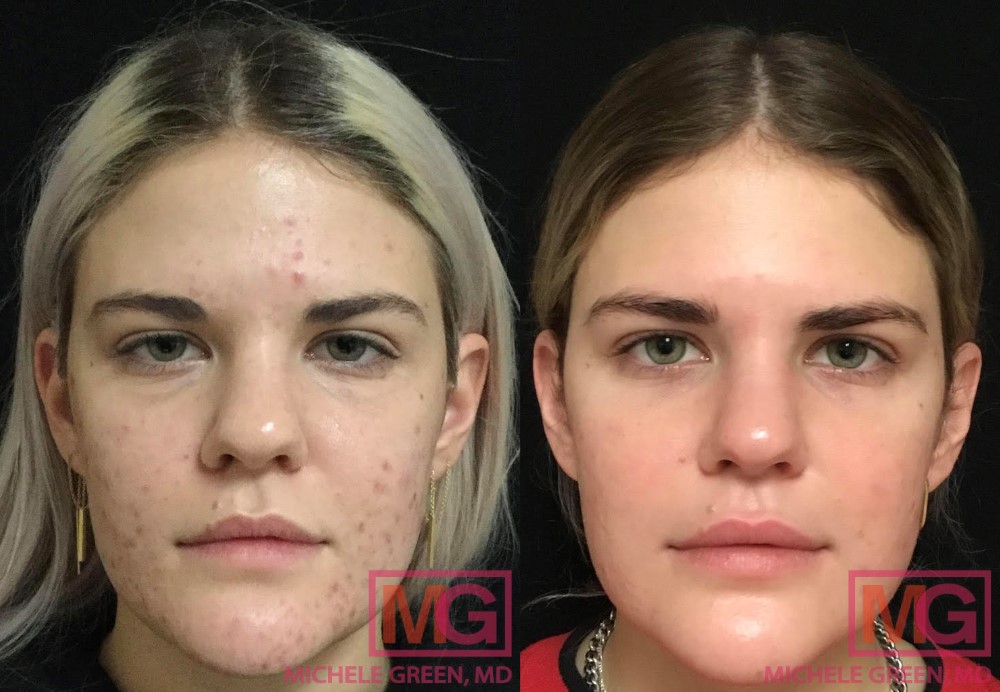
Female treated for acne with Accutane: 5 months
How to get started with acne rosacea treatment today
Acne rosacea can appear as pimples, pustules, facial redness, and visible blood vessels on the skin’s surface. For many, acne rosacea flare-ups can negatively impact self-esteem. Luckily, Dr. Green offers a variety of cutting-edge treatments for reducing breakouts, facial redness, and other symptoms of acne rosacea. Topical and oral treatments can help to reduce inflammation and breakouts, while in-office treatments such as the VBeam laser can minimize redness on the skin. When you work with Dr. Green, she will employ a combination approach of treatments to help you control your acne rosacea flare-ups and achieve clear, radiant skin.
Dr. Michele Green is an internationally renowned board-certified dermatologist with over 25 years of experience providing her patients worldwide with the best non-invasive treatment options, including the VBeam laser for managing acne rosacea. Dr. Green is consistently voted one of the best healthcare providers in New York City by Castle Connolly, Super Doctors, The New York Times, and New York Magazine for her dedication to her patients and expertise. When you consult with Dr. Green at her private dermatology office in the Upper East Side neighborhood of Manhattan, she will work with you to develop a customized acne rosacea treatment plan best suited to address your specific skin concerns. To learn more about acne rosacea treatment, schedule a consultation with Dr. Green by calling the NYC-based office at 212-535-3088 or contacting us online.
 212-535-3088
212-535-3088